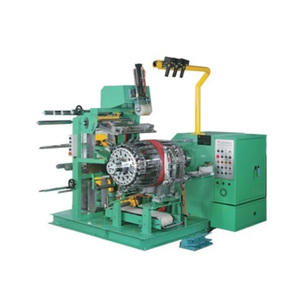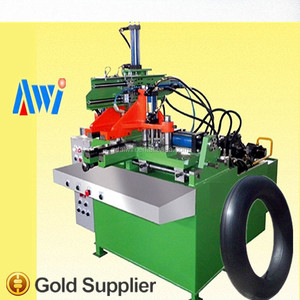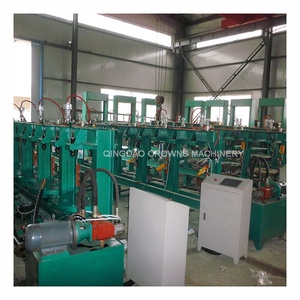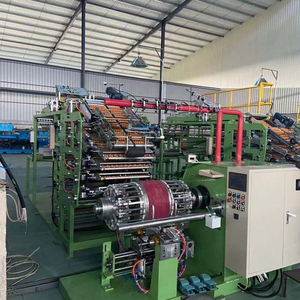(328 products available)






































There are 3 main types of motorcycle tyre tube making machine 1. Full Automatic, 2. High Speed, 3. Special Shaped Tube.
Full Automatic Motorcycle tyre tube making machine
The fully automatic motorcycle tire tube production line is advanced equipment. It has a high degree of automation and can realize the automatic production of tire tubes from raw material feeding to finished product output. The production line can improve production efficiency, ensure the stability and consistency of product quality, and reduce labor costs. Generally, the production capacity of fully automatic tire tube production lines can reach dozens of tire tubes per minute, and the specific production capacity can vary according to equipment models and customer requirements.
High Speed Motorcycle tyre tube making machine
The high-speed motorcycle tire tube-making machine is designed to meet the needs of high production efficiency and large output. These devices usually have high-speed operations, with production speeds reaching hundreds of tire tubes per minute. The key to high-speed tire tube-making machines lies in their precision, stability, and control systems. In addition to high-speed operation, high-precision sensors and control systems are usually equipped to ensure the stability and consistency of product quality during high-speed production. In addition, high-speed tire tube-making machines may adopt modular and integrated designs, making maintenance and equipment adjustment more convenient and efficient.
Special Shaped Tube Motorcycle tyre tube making machine
The specialized motorcycle tire tube-making machine can manufacture non-standard or customized tire tubes, such as special shapes, sizes, and materials. These devices are equipped with flexible production lines and adjustable parameters, which can meet specific requirements and provide higher adaptability and versatility. Specialized tire tube-making machines are particularly important in some industries, such as high-performance racing, special vehicles, and new material applications. In these fields, the tire tubes need to be optimized for performance, durability, and adaptability to meet specific requirements and challenges.
Regular Cleaning
Remove any debris, dust, or rubber particles from the machine's surface and components. Pay attention to the cutting and shaping tools, as any buildup can affect their performance.
Lubrication
Follow the manufacturer's guidelines for lubrication intervals and recommended lubricants. Use the appropriate lubricants for each component, such as bearings, gears, and moving parts, to ensure smooth operation and reduce friction.
Component Inspection
Regularly inspect all components of the tyre tube machine, including the extruder, moulds, cooling system, cutting system, and assembly units. Check for signs of wear, damage, or misalignment. Replace or repair any worn-out or damaged parts promptly to prevent further issues and maintain optimal performance.
Alignment and Tensioning
Ensure that all components of the machine are correctly aligned and adjusted. This includes the alignment of the extruder with the moulding section, the cutting blades, and the assembly units. Check and adjust the tension of belts and chains as needed to prevent slippage and maintain accurate timing between different machine parts.
Electrical System Inspection
Check the entire electrical system, including wiring, connections, and control panels, on a regular basis. Look for loose connections, frayed wires, or other potential issues. Address any electrical problems promptly to avoid machine downtime and ensure reliable operation.
Cooling System Maintenance
Check the cooling system, including water flow, temperature control, and cooling efficiency. Clean the cooling channels and ensure they are free from any blockages. Monitor the cooling system's performance to maintain the required temperature during the tube formation process.
Calibration and Adjustment
Calibrate and adjust the machine's settings and parameters, such as temperature, pressure, and cutting length, according to the manufacturer's specifications. This ensures consistent quality and precision in the production of tyre tubes.
Safety Precautions
Follow all safety guidelines and procedures while maintaining the tyre tube-making machine. Use appropriate personal protective equipment (PPE) and ensure all safety guards and devices are in place and functioning correctly.
The decision to invest in a motorcycle tire tube production line is no small feat, and there are many factors that must be considered before any action is taken. These factors include:
Manufacturers and end users can easily repair and maintain tube vulcanizing machinery if they have the right skills. Here are some basic steps for tube vulcanization machinery maintenance and repair:
Check the motorcycle tire tube vulcanization machine
Examine the entire tube vulcanization machine, including its components, for any visible damage, wear and tear, or leaks. Pay close attention to check the pressure gauge, control panel, and other important parts.
Identify and fix any visible damage
If there is any damage, replace the affected parts, such as fasteners, seals, and gaskets. If there is a leak, tighten the loose parts or replace the damaged seals and gaskets.
Check the electrical system
Inspect the electrical system, including cables, connectors, and the control panel, for any problems. Make sure the control panel works well and there are no loose connections or damaged cables in the entire system.
Check the heating system
Inspect the heating system components, such as the heating plates and heating elements, to see if there is any damage. Ensure the heating system works well and maintains the required temperature for tire tube curing.
Check the pressure control system
Inspect the pressure control system components, such as the pressure gauge, pressure regulator, and the whole pneumatic system, to see if there is any damage. Ensure the pressure control system works well and maintains the required pressure during the tire tube curing process.
Check the cooling system
Inspect the cooling system components, such as cooling water pipes, cooling plates, and cooling water circulation system, to see if there is any damage. Ensure the cooling system works well and maintains the required cooling effect after the tire tube curing process is complete.
Check the machine alignment
Check if the machine components' alignment and installation are correct according to the motorcycle tire tube-making machine's manual. Ensure that all parts are properly installed and aligned to ensure smooth and accurate operation of the machine.
Furthermore, if there are any problems or difficulties that cannot be solved, consult the manufacturer's manual or contact the manufacturer's technical support for professional guidance and assistance.
Q: How long does it take to set up a new motorcycle tyre tube making machine?
A: The time required to set up a new tyre tube-making machine varies depending on the equipment and other factors. Typically, it can take anywhere from a few days to a few weeks. Some factors that affect the setup time include the complexity of the machine, the availability of skilled personnel, and the integration with existing production processes.
Q: What is the average production rate of a motorcycle tyre tube-making machine?
A: The production rate of a tyre tube-making machine varies depending on the machine's design, size, and production capacity. Generally, production rates can range from a few hundred to several thousand tubes per day. Moreover, some advanced machines have higher production rates due to automation and efficiency.
Q: What are the common quality control measures in motorcycle tyre tube production?
A: Common quality control measures include regular inspection of raw materials, in-process monitoring of critical parameters, inspection of finished tubes, and adherence to international quality standards.
Q: Can the motorcycle tyre tube-making machine be adapted to produce different tube sizes?
A: Yes, some tyre tube machines can be configured to produce various tube sizes. However, changing the setup and other components may be necessary to accommodate different dimensions.